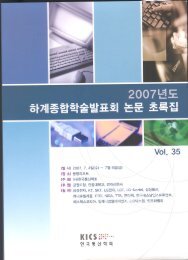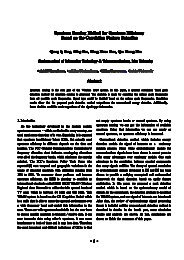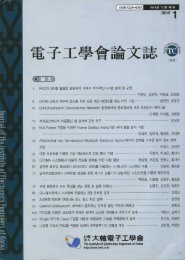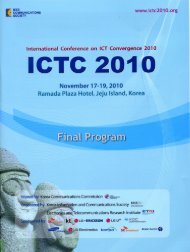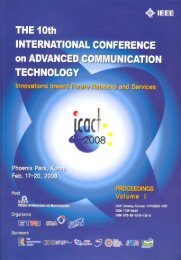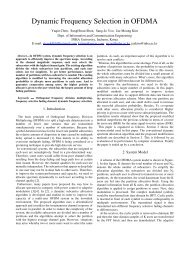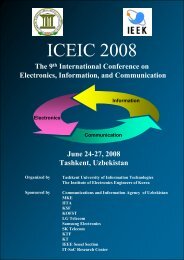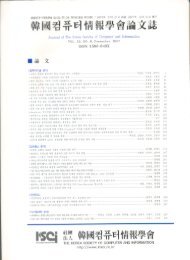Untitled
Untitled
Untitled
Create successful ePaper yourself
Turn your PDF publications into a flip-book with our unique Google optimized e-Paper software.
here, αm and β m represents the multiplicative distortion at the<br />
desired subcarrier and the ICI, respectively. If the channel keeps<br />
invariant during a block period, β m will be zero, which means no<br />
ICI.<br />
In the general case where the multipath cannot be regarded as<br />
time-invariant during a block period, (7) can be expressed in<br />
vector form as:<br />
Y = H X + W<br />
(9)<br />
where Y=[Y 0,…,Y N-1] T , X=[X 0,…,X N-1] T , W=[W 0,…,W N-1] T , and<br />
⎡a0,0 a0,1La0, N −1<br />
⎤<br />
⎢<br />
⎥<br />
a1,0 a1,1 a1,<br />
N −1<br />
H<br />
⎢ L<br />
=<br />
⎥<br />
⎢M O M ⎥<br />
⎢ ⎥<br />
⎢a a a ⎥<br />
⎣ N−1,0 N−1,1 N−1, N−1⎦<br />
here, a m,k in (10) is defined as<br />
( m−k) − j2 π k( L−1)/ N<br />
+ HL1 e ,0 ≤(<br />
m, k) ≤ N −1.<br />
* * * *<br />
= + (14)<br />
⎤<br />
⎦<br />
(10)<br />
( m−k) ( m−k) − j2 π k/ N<br />
amk , = H0 + H1 e + K (11)<br />
−<br />
In this paper, we assume the multipath fading channel is<br />
slowly-varying, so most energy concentrate in the dominant<br />
adjacent subcarriers, the ICI terms which do not significantly<br />
affect Y m in (10) can be ignored. And then by transforming the<br />
matrix H of order N× N to a block-diagonal matrix H * of order<br />
×<br />
(N-q)(q+1) (N-q)(q+1). We obtain:<br />
where,<br />
⎡Aq/2<br />
0 ⎤<br />
⎢<br />
⎥<br />
A<br />
*<br />
q /2+ 1<br />
H =<br />
⎢ ⎥<br />
⎢ O ⎥<br />
⎢ ⎥<br />
⎢⎣0AN−− 1 q/2⎥⎦<br />
⎛an−q/2, n−q/2 L an−q/2,<br />
n L<br />
0 ⎞<br />
⎜ ⎟<br />
⎜an− q/2+ 1, n−q/2 ⎟<br />
⎜ M M ⎟<br />
⎜ ⎟<br />
⎜ann , −q/2<br />
O<br />
⎟<br />
An<br />
= ⎜ ⎟<br />
⎜ O<br />
an+<br />
1, n+ q/<br />
2 ⎟<br />
⎜ M M ⎟<br />
⎜ ⎟<br />
⎜ an+<br />
q/2− 1, n+ q/2⎟<br />
⎜<br />
⎟<br />
0<br />
an+ q/2, n a ⎟<br />
⎝<br />
L L n+ q/2, n+ q/2<br />
⎠<br />
(12)<br />
(13)<br />
We can locate some of the unused subcarriers at the first q/2 and<br />
the last q/2 IFFT grids to get the estimation of all symbols. Then,<br />
the input-output relationship of the multipath channel is expressed<br />
in a vector form as:<br />
where,<br />
Y H X W<br />
*<br />
T<br />
X ⎡xq/2<br />
xq/2+ 1 L xN−1<br />
−q/2<br />
= ⎣<br />
xn = ⎡<br />
⎣Xn−q/2 Xn− q/2+ 1 L X ⎤ n+ q/2⎦<br />
*<br />
T<br />
Y ⎡yq/2 yq/2+ 1 L y ⎤ N−1 −q/2<br />
= ⎣ ⎦<br />
yn = ⎡<br />
⎣Xn−q/2 Xn− q/2+ 1 L X ⎤ n+ q/2⎦<br />
*<br />
T<br />
W ⎡wq/2 wq/2+ 1 L w ⎤ N−1 −q/2<br />
= ⎣ ⎦<br />
wn = ⎡<br />
⎣Wn−q/2 Wn− q/2+ 1 L W ⎤ n+ q/2⎦<br />
T<br />
T<br />
T<br />
(15)<br />
V. FREQUENCY DOMAIN EQUALIZER<br />
A. Zero-Forcing Equalizer<br />
Zero-Forcing equalization compensates both multiplicative<br />
distortion and ICI by multiplying the inverse of , which is the<br />
*<br />
estimated value of H , to (14). The resulting signal can be<br />
expressed as:<br />
* 1 * − % % (16)<br />
X = H Y<br />
where X % is the estimated signal, and<br />
H%<br />
* −1<br />
−1<br />
⎡ A%<br />
0 0 ⎤<br />
⎢ ⎥<br />
−1<br />
⎢ A%<br />
1 ⎥<br />
=<br />
⎢ O ⎥<br />
⎢ ⎥<br />
−1<br />
⎢0 A% ⎣<br />
⎥ N−− 1 q⎦<br />
Also, (16) can be rewritten as<br />
1<br />
X% −<br />
= A% y , q/2≤ n≤ N −1<br />
−q/<br />
2.<br />
(18)<br />
n n n<br />
Finally, the transmitted symbols are estimated by selecting<br />
the elements in the middle of X .<br />
n<br />
%<br />
B. MMSE Equalizer<br />
H %<br />
*<br />
(17)<br />
Using the fact that the ICI power is localized to the dominant<br />
adjacent subcarriers, only a few neighborhood subcarriers can be<br />
used for equalization without much performance penalty. We find<br />
the solution for each desired subcarrier individually[4]. The<br />
problem of MMSE is to find the equalizer coefficient vector<br />
g m=[g m,0,…,g m,q-1] which minimizes the mean-squared error<br />
2<br />
ˆ { m − m }<br />
E X X<br />
where ˆ T<br />
X m = gmy and , y<br />
m y ⎡Y , Y ⎤<br />
where Hm=A m.<br />
The MMSE solution is<br />
m ( m− q/2) L m is then<br />
( m+ q/2)<br />
= ⎣ ⎦<br />
ym = Hmx+ w (19)<br />
m<br />
g R R −<br />
= (20)<br />
1<br />
m X ,<br />
mym ym<br />
assuming H is known, x is a zero-mean i.i.d. random vector with<br />
variance<br />
2<br />
σ x , and w is an AWGN vector with variance<br />
{ } 2<br />
H H<br />
X mym m m<br />
2<br />
σ w ,then<br />
R = E X y = σ xh (21)<br />
m<br />
where hm is the q/2 th column of the matrix H m, i.e.,<br />
Also, we can get<br />
hm = ⎡<br />
⎣am− q/2, q/2 , L , a ⎤<br />
(22)<br />
m+ q/2, q/2⎦<br />
H 2 H 2<br />
{ } σ σ<br />
R = E y y = H H + wIq (23)<br />
ymm m x m m<br />
After inserting (21) and (23) into (20), the q-tap equalizer vector<br />
g m becomes<br />
T



